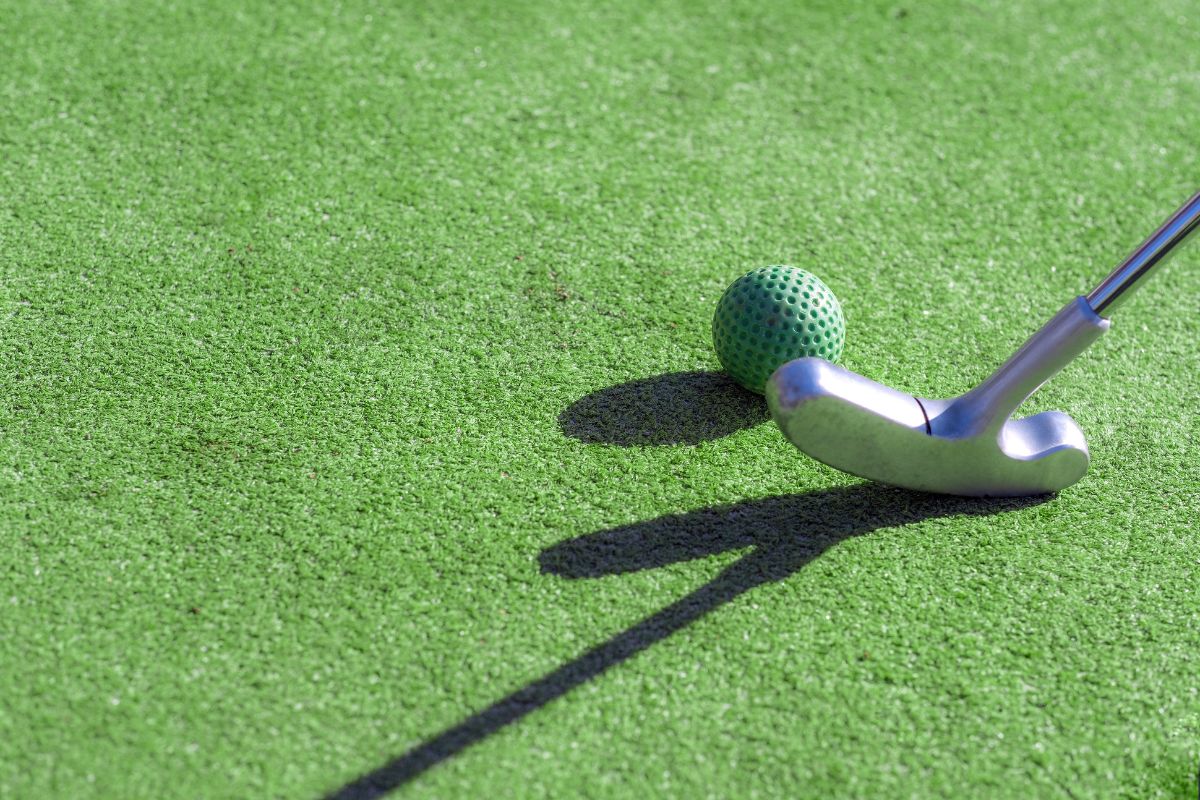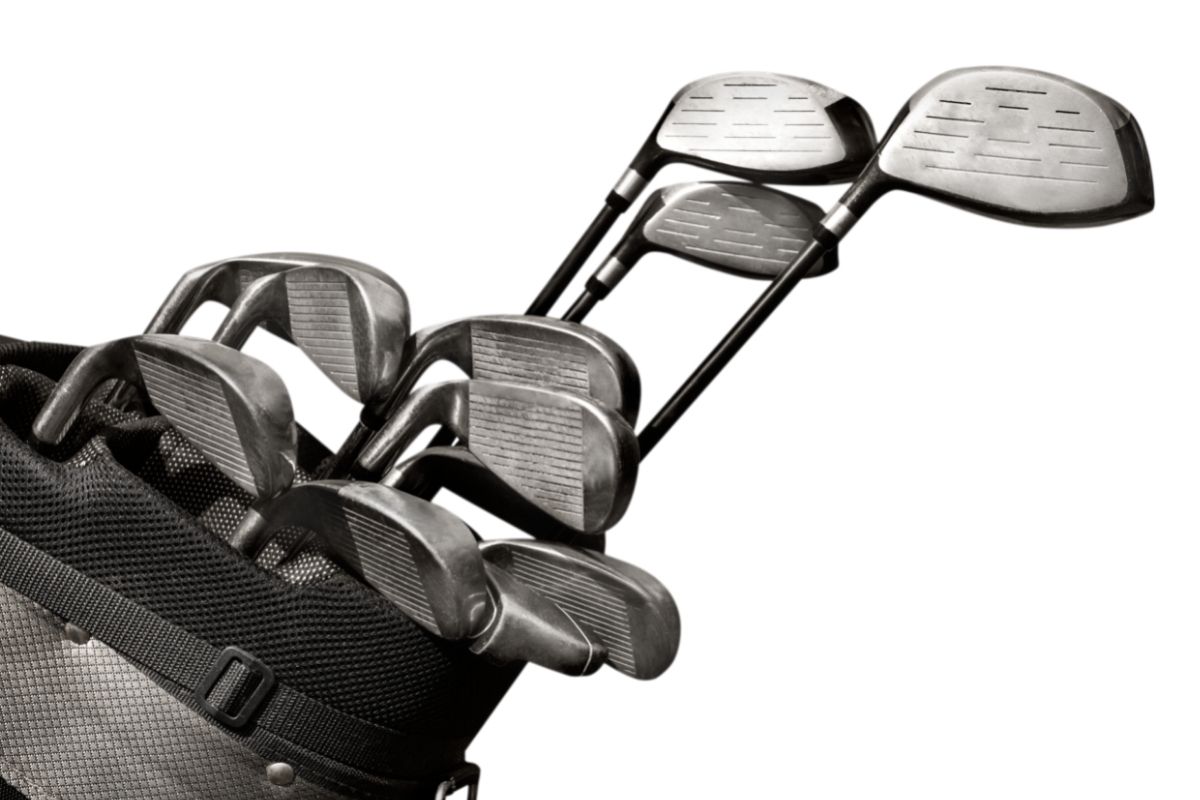We occasionally recommend products we love and might be paid a share of the sale.
Whether you are a beginner to the game of golf, or you have been playing for decades, everyone of all skill levels are always trying to improve their skills, especially when it comes to developing your short game.
The short game is absolutely necessary in order to achieve lower scores and keep the same level of play from round to round.
Let’s be honest: on any given day, our ball striking may be phenomenal or it could be a little bit off. There’s no telling what will happen from day to day. Having said that, it is necessary for us to be capable of chipping with at least some accuracy whenever we hit the course.
But how can we make sure that we are chipping correctly every time? Well, the first thing that you have to think about is the club selection.
When playing around the greens, the first step is determining which club is most suited for the conditions. You have a number of options available to you, but which one is right for the particular scenario?
In this article, we will answer this question, as well as give you some top tips on how to improve your chipping on the green.

What Are The Best Clubs For Chipping?
Though the right club to use for chipping will depend mostly on the situation, in general, the safest bet is to use a wedge.
You can use a wedge with a loft of 48, 52, 56, or even 60 degrees. Golfers have access to a wide variety of wedge options, and the one they select is determined by the type of chip shot as well as their general level of play.
There are four circumstances in which golfers are required to take chip shots, and so we are going to cover each of them, as well as give you some options on how you should play in these scenarios.
Scenario 1 – What Club To Use When You Have A Lot Of Green?
In this scenario, you have access to a lot of accessible green. Because of this, you are free to use whichever club you are more confident in using, and one that is able to make firm contact with the ball.
Option 1
A bump-and-run shot is commonly played by the golfer who has a higher handicap. This shot is played with a pitching wedge, which has a loft angle of 46 or 48 degrees. Some players may even choose a 7, 8 or 9-iron depending on their preferences and how much green they have to work with.
The golfer employs a technique that is very similar to putting and gives the ball a light tap in order to flight the ball a short distance before allowing the ball to travel the remaining distance to the hole on the ground.
This is the most basic type of chip shot, and it is also the one that is the easiest to do successfully. This shot poses a risk that is far lower than that posed by any other chip shot.
To execute this shot successfully, the golfer should not swing the club but instead use a less complicated motion similar to the putting stroke.
Option 2
If you are a more experienced golfer, you may choose to select a club that has a higher loft and then reduce the loft of the club by pushing the ball further back in your stance. This strategy only works if you first select a club with a higher loft.
Some individuals may use the Sand Wedge, which has a loft of 54 or 56 degrees, in all of their chipping shots regardless of the conditions.
This is typically done by golfers who find that the club works best for them and they are very comfortable using it often. They typically transform it into multiple different lofts by adjusting where the ball is positioned, changing the angle of the club face, as well as shifting where the player’s hands are positioned on the club.
This is the approach that Phil Mickelson often takes to the course. While the clubs that other players choose to use are not set in stone, you should expect some variety.
A golfer may also decide to go with option two if there is a considerable contour on the green that will make the “bump and run” shot more difficult.
Situation 2 – What Club To Use When You Have To Hit The Ball Further?
In the second scenario, it is required for the ball to go a little further than it did in the first scenario. The golfer will almost definitely choose a wedge where the loft is somewhere around 52 to 60 degrees since this is the most beneficial range for their game.
This might be a gap wedge, a sand wedge, or a lob wedge, depending on the specifics of the situation. Again, the most essential thing is to pick a club that gives you the most confidence in your ability to make solid contact with the ball.
This is the single most important thing you can do to improve your game. There is nothing more annoying than missing a shot completely, watching it move only a few inches or feet, and then having to deal with the same problem again.
Option 1
The golfer who wants to play the ball lower and let it roll out can pick a wedge with an angle between 52 and 56 degrees, play it a touchback in the stance, and carry out a straightforward motion to get the ball soaring in the air.
The golfer will only need to hit the ball far enough to get it to the putting surface; the rest of the shot will be completed with the ball rolling on the green.
Option 2
The player has the option of carrying the ball at least halfway towards the hole before letting it roll the rest of the way on its own to complete the hole.
This golfer would utilize either a 56 or 60-degree wedge and the location in their stance from which they played the ball may shift depending on the circumstances.
Both the lie that the golfer now possesses and the look of the grass around the ball can have a considerable impact on the decisions that must be made.
Situation 3 – What Club To Use When The Ball Has Less Room To Roll?

Because we are now in this difficult situation, there is less chance that the ball will make its way into the gimme zone. In this scenario, a wedge with an angle of 56 or 60 degrees would be the most appropriate tool to use.
Under no circumstances should you try to force a shot. If you are unclear about which path to take, choose the more careful one and make sure that you get on the green and are putting the ball for the next shot.
Option1
Use a wedge with a 56-degree loft angle, fly it into the green or the fringe of the green just far enough, and then allow it to roll out.
The key to finding success in this circumstance is to have delicate hands and to let the ball make a soft impact on the ground. Retaining patience throughout the downswing and gently opening up the club face will be necessary.
Option 2
To get the ball to stop pretty near to the hole, use a wedge that has a loft angle of 60 degrees, move the ball to within a few feet of the hole, then play the shot at a height that will allow the ball to stop quite close to the hole.
Scenario 4 – What Club To Use When We Are Very Short On Space?
In this scenario, there is very little wiggle room for us to roll the ball. It is easy to steer clear of these sticky situations by working on your swing or decision-making abilities during the approach shot and by making sure that you do not “short side” yourself when playing around a green.
The phrase “short side” refers to the situation in which the ball is played so that it lands just off of the green that it is closest to the position of the pin.
These pins, which have been placed in such a way that they are close to the edge, are intended to entice you to shoot for the pin, which can ultimately result in you missing it on the “short side.”
This very certainly guarantees that at least one bogey, if not more, will take place. However, all is not lost, as it is still possible to go up and down to save par provided adequate practice has been done and the correct club is used.
Option 1
Make use of a flop shot by selecting the wedge with a loft of 60 degrees or more. In most circumstances, this will require bringing the club head slightly forward in the stance while retaining a posture that is quite open.
A right-handed golfer should aim ever-so-slightly to the left and make a downward, through-and-through swing at the ball. The ball needs to take off into the air on a high, steep angle and land softly. It requires considerable practice and soft hands to pull off the flop shot consistently.
Option 2
If you are unable to make this shot, you should try to aim for the center of the green and make it there if possible. This will allow you to have an easier putt for the shot that comes after this one.
Do not make the situation any more difficult for yourself by leaving it in the bunker or short of the green. Before you go on to the next step, you need to be sure that the ball is on the putting surface.
Top Tips For Chipping
Practice Makes Perfect
There are many different settings available for you to practice chipping in if you want. One option is to practice at home if you have a room that has a soft carpet. Of course, only do this if it is safe, and ensure that you have plenty of room around you while doing so.
In order to become an expert short game player, this can help you achieve the ideal motion and accumulate the necessary practice time.
In addition, there is often no cost associated with practicing your chipping and putting on the practice green at public golf courses.
After practicing chip shots for 15 to 20 minutes, one of the games that we recommend playing is counting how many times you can go up and down out of 10. Keep track of how much progress you’ve made over the course of time.
Your goal should be to achieve a success rate of 60 percent during practice and a success rate of 50 percent while actually playing golf. When chipping, your form does not need to be perfect; all you need is something that can be maintained under pressure and that can be repeated.
Be Aware Of The Changes in Your Pace
The key here is to not go too fast or slow during your chipping stroke. It is important to keep a smooth tempo during the whole process of chipping.
When it comes to chipping, the “death move” is the rapid acceleration that leads to the yips.
To do a chipping move correctly, you must maintain the same speed. If you are having trouble with this aspect of chipping, then this should be the very first thing that you should practice.
While keeping a constant speed is easier said than done, with enough time and experience it will become second nature to you.
Put “The Bounce” To Work For You
Find a tactic that makes use of the bounce that your wedge offers, and use it to your advantage. Pay attention to what the pros are doing, as they are taking advantage of the bounce in order to offer themselves a bigger margin of error while chipping the ball.
When you use an excessive amount of leading-edge, it increases the likelihood that your shots will be hit thin or fat producing a poor result.
Try To Make Sure That Your Next Shot Will Be A Putt
While you can try any number of tactics, the only thing that you have to do is to make your next shot a putt at the very least. It is completely fine for you to hit the ball 10–20 feet past the hole if this is what it takes to complete the shot. Just be sure that you are putting.
Get A Wedge That Has An Angle Of 60 Degrees
If you want to take golf seriously and become a great player, you need a wedge with a loft angle of at least 58 degrees and preferably 60 degrees.
If you can get the hang of striking the ball with the club, the game will become a lot easier for you to play. As a result of this, you’ll be able to target a greater number of pins and holes in a more aggressive manner.
It’s likely that golfers who played the game during a time when the greens were more forgiving and slower may try to convince you otherwise, but these clubs are fantastic for teaching novices how to hit the ball accurately and consistently.
Don’t Overcomplicate Things
Keep the action of chipping as simple as possible to ensure the best results when you can. Playing like Steve Stricker or Jason Day is a great tactic to use in the early spring, when the ground is still a little bit muddy and when you might be feeling cautious.
Remove your hands from the way and work on developing a chipping motion that is fluid and is dependent on the tempo at which you play. By adopting this particular move, you will ensure that you make powerful contact with the ball.
You don’t need to have a full swing like Tiger Woods or smash flop shots, but you do need to have a fundamental chipping motion that you can own in order to play outstanding golf!
Getting Better Scores

It’s possible that the short game holds the key to improved and more consistent golf play, but you shouldn’t be telling your other playing partners about this just yet.
Find a way to practice your short game for at least one to two hours each week, and you might be surprised at the difference it makes in your score.
If you only manage to hit eight of the greens in regulation but you are certain that you can make par on each of those eight greens, you will have ten chip shots that you need to make. To begin, you should make it a goal to achieve an up-and-down for par on four of these 10 unique situations.
To get better scores, you should first concentrate on getting as close as possible to each green in regulation and then figure out how to save par fifty percent of the time.
This will help you play better when you can’t reach all of the greens in regulation. This uncomplicated strategy is a wonderful tool for developing the abilities essential to obtain a score in the 30s for nine holes and in the 70s for 18 holes. Whatever your goal score is, improving your short game is the most important factor in achieving the target.
Summary
If you want to be successful at golf, you don’t need to be a great ball striker; all you need is the ability to control your game and put in the practice time to improve your chipping. Choosing the right club is essential for this, though the right option will depend on your current situation.
It doesn’t matter how long you have been playing, you can always get better at chipping and quickly bring down your scores.
- Funny Golf Terms - February 21, 2023
- How To Play Vegas Golf Game - February 16, 2023
- How To Play Wolf Golf Game - February 16, 2023








